Saturday, 24 May 2014: Narbonne, above and below ground
Written

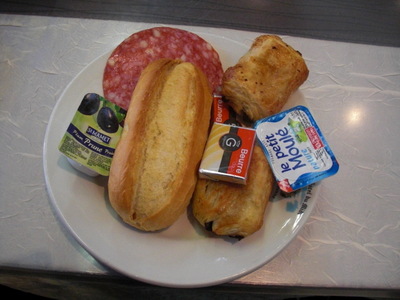 The hotel is very proud of hte stylishly asymmetrical backs of its break-fast room chairs, so the staff take care to set each chair at an angle, to give a sort of sails-before-the-wind effect. In the mirror at the far end of the room, you can see me taking the photo.
The hotel is very proud of hte stylishly asymmetrical backs of its break-fast room chairs, so the staff take care to set each chair at an angle, to give a sort of sails-before-the-wind effect. In the mirror at the far end of the room, you can see me taking the photo.
Here's the entirely adequate breakfast I assembled off the buffet (which was more elaborate than an Ibis Budget but less so than a full-scale Ibis)—a bread bun, two mini pains au chocolat, butter, spreadable white cheese, plum jam, and dry salami. I could also have had ham, cereal, yogurt, or fresh fruit. The hot chocolate dispensed by the coffee machine was very good. The bread was a little insubstantial, and the butter was unsalted, but these are mere quibbles.

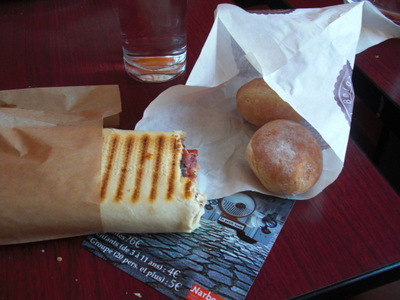 David slept really late, finally emerging about 11:45 a.m. and feeling crummy. We set out in search of a pastry for him and made it all the way to the Place de l'Hotel de Ville before settling at Romulus Caffé, just a couple of doors from l'Agora. They had croissants left from breakfast, so he had two of those and a hot chocolate served in a double-walled clear plastic cup.
David slept really late, finally emerging about 11:45 a.m. and feeling crummy. We set out in search of a pastry for him and made it all the way to the Place de l'Hotel de Ville before settling at Romulus Caffé, just a couple of doors from l'Agora. They had croissants left from breakfast, so he had two of those and a hot chocolate served in a double-walled clear plastic cup.
I, on the other hand, was ready for lunch and chose a raw ham, tomato, tapenade, and Emmenthal panini and two tiny cream-filled doughnuts.
As I had expected it would, a little food improved David's outlook considerably.
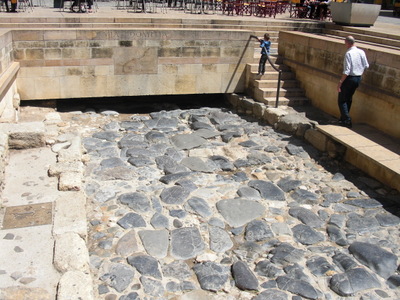
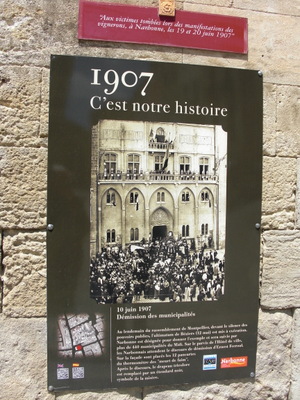 From the Romulus, it was just a few steps to have a look at the excavated section of the Via Domitia (named after the emperor Domitian) in the center of the square. The café tables and chairs in the background are at present ground level, and the bottom of the pit consists of a small portion of the original roadbed. If you follow its line across the square beyond this photo, it is continued in Rue Droite ("Straight Street"), which at least for its first few blocks follows the arrow-straight route of the original Roman road, which connected Italy with Spain. If you follow it in the other direction, it leads across the oldest (and once the only) bridge over the river/canal. The bridge is unusual in that was (and still is) lined with shops on both sides, all the way over; you can't tell you're on a bridge at all until you emerge and realize you're on the other side of the water. From both ends, it just looks like a narrow shopping street.
From the Romulus, it was just a few steps to have a look at the excavated section of the Via Domitia (named after the emperor Domitian) in the center of the square. The café tables and chairs in the background are at present ground level, and the bottom of the pit consists of a small portion of the original roadbed. If you follow its line across the square beyond this photo, it is continued in Rue Droite ("Straight Street"), which at least for its first few blocks follows the arrow-straight route of the original Roman road, which connected Italy with Spain. If you follow it in the other direction, it leads across the oldest (and once the only) bridge over the river/canal. The bridge is unusual in that was (and still is) lined with shops on both sides, all the way over; you can't tell you're on a bridge at all until you emerge and realize you're on the other side of the water. From both ends, it just looks like a narrow shopping street.
Nearby, on the wall of the town hall, was this plaque detailing the events of the Occupation of Narbonne in November of 1907 that took place on this spot. Similar plaques appear all over the historic district, describing different phases of the events. As nearly as we can piece together, the local winemakers staged a major protest of economic conditions—the sypathetic mayor even posted a "thermometer" of the number of those dying of starvation in the city, took down the tricolor, and flew a black flag instead. When ordered to disperse the crowds, the local regiment refused to fire on them and went over to the protester's side. Eventually, national troops occupied the city and put down the revolt.
We still had some time to kill before the museums opened (except at the height of tourist season, Narbonne observed the usual French schedule of closing everything from noon to 2 p.m.), so I went back to the Office de Tourisme (about the only thing that stays open during lunch) for a new map and museum-pass brochure, which we'd forgotten to bring from the hotel, and we bought some postcards and drifted toward our next stop a few blocks away.

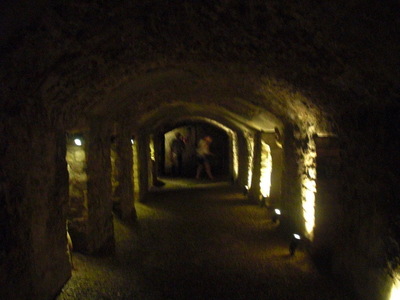 The roman horreum is considered one of Narbonne's premier attractions, open to the public only since 1975. Although it's subterranean, dank, and arguably creepy enough to invite the inference, the word "horreum" has nothing to do with horror. It's just the underground storage cellar of a very large Roman commercial establish of some sort. It's thought to have been three- or four-sided originally, arranged in a square around an unexcavated center section, but only parts of two sides have been excavated and cleaned out. Now, each small side chamber of the central arcade showed here on the right serves to display some object or artifact found during the excavations. I love the great job my little digital camera does of taking nonflash photos by the rather dim lighting.
The roman horreum is considered one of Narbonne's premier attractions, open to the public only since 1975. Although it's subterranean, dank, and arguably creepy enough to invite the inference, the word "horreum" has nothing to do with horror. It's just the underground storage cellar of a very large Roman commercial establish of some sort. It's thought to have been three- or four-sided originally, arranged in a square around an unexcavated center section, but only parts of two sides have been excavated and cleaned out. Now, each small side chamber of the central arcade showed here on the right serves to display some object or artifact found during the excavations. I love the great job my little digital camera does of taking nonflash photos by the rather dim lighting.
On arrival, we started by buying a pair of the city's museum passes, which are a great deal. A single ticket to any of the seven city museums is 4 euros, but the pass costs just 9 euros and is good for one free admittance to each of them anytime in the next two weeks. We had time for only three, but we still saved money.
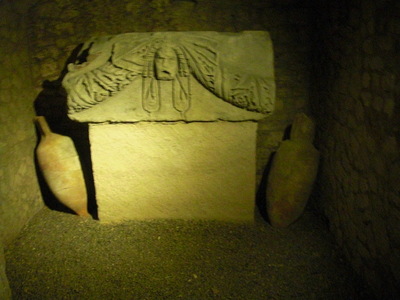
 As you can see from my photos, especially the one on the right here, they are developing an algae problem because of the lights. All the photos under these lighting conditions have a greenish caste, but you can really see the patches of green on the right-hand photo.
As you can see from my photos, especially the one on the right here, they are developing an algae problem because of the lights. All the photos under these lighting conditions have a greenish caste, but you can really see the patches of green on the right-hand photo.
David speculated that they might eventually have to seal the place and flood it with pure nitrogen for a few weeks to kill off the growth. My take was that overnight exposure of each artifact to a really strong UV light source, followed by a light brushing a few days later to remove debris, might do the trick. Any ideas among my readers? Or does anyone know how museums routinely deal with the problem?
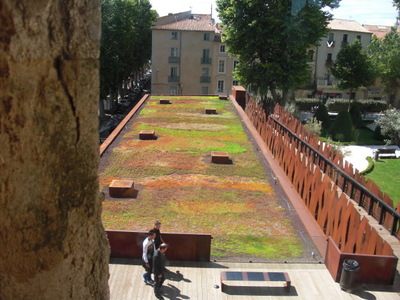
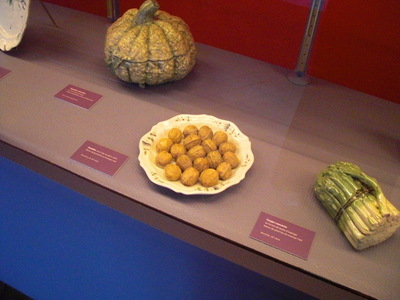 We still had some time left after the Horreum, so we chose the museum of art and history, the smaller of the two in the Bishop's Palace. On the way up the stairs to its entrance, I was able to get this shot out a window overlooking the Bishop's Terrace and its sedum garden, and to answer for myself the question of whether the colors were supposed to form an image or a word—apparently not, or if so, it's long since been obliterated by random growth.
We still had some time left after the Horreum, so we chose the museum of art and history, the smaller of the two in the Bishop's Palace. On the way up the stairs to its entrance, I was able to get this shot out a window overlooking the Bishop's Terrace and its sedum garden, and to answer for myself the question of whether the colors were supposed to form an image or a word—apparently not, or if so, it's long since been obliterated by random growth.
The photo on the right shows a few pieces from the collection or ornamental china. The melon and the asparagus open up and can be used as serving pieces (as could, e.g., the soup tureen in the shape of a life-size cabbage and the terrine in the shape of a life-size duck), but the plate of walnuts is just that—a china plate covered with (attached) china walnuts. I guess you could pile more (real) walnuts on top . . . Others displayed china almonds, olives, etc.
The temporary exhibition was of 20th-century art, which, we were pleasantly surprised to find, looked pretty surprisingly classical. Only a few pieces were abstract or looked cubist or otherwise distorted. We found some gorgeous still lives (we love still lives). As the explanatory materials said, not all 20th-century art is "modern" looking, and lots of it is entirely worthwhile even though nothing in the exhibition was by anyone you'd ever heard of. We had to agree.
The permanent collection also didn't feature much in the way of big names, although we came across a Titian, a Nattier, and several Breughels, of different first names (I don't think any of them was the famous one, Pieter the elder, though you could see the resemblance).
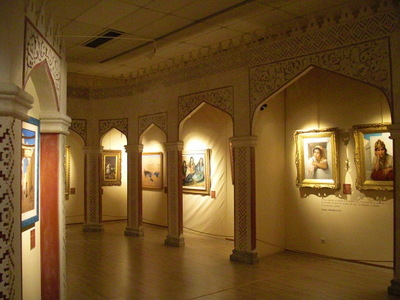
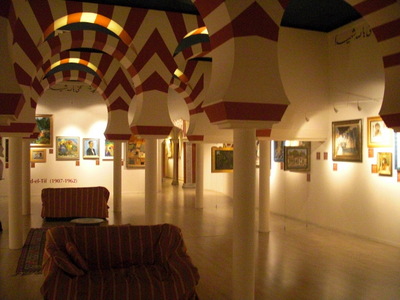 Extremely revelatory, at least to us, was a major exhibit on French "orientalism." When Americans say "oriental," they usually mean Asian, but it turns out that, in French, "oriental" means middle-eastern! Boy did that cast new light on a lot of stuff. The "orientalist" movement was a major one in France, and the curators thoughtfully provided a time line of it, beginning in the early 18th century with the appearance of the first French edition of the 1001 Nights and Montesquieu's Persian Letters, running through the French presence in north Africa (inspiring operas, novels, paintings, plays, memoires, etc.), and finally ending in 1962 when the French left Algeria. These two photos show the decor of the two rooms dedicated to examples of the movement. Wow.
Extremely revelatory, at least to us, was a major exhibit on French "orientalism." When Americans say "oriental," they usually mean Asian, but it turns out that, in French, "oriental" means middle-eastern! Boy did that cast new light on a lot of stuff. The "orientalist" movement was a major one in France, and the curators thoughtfully provided a time line of it, beginning in the early 18th century with the appearance of the first French edition of the 1001 Nights and Montesquieu's Persian Letters, running through the French presence in north Africa (inspiring operas, novels, paintings, plays, memoires, etc.), and finally ending in 1962 when the French left Algeria. These two photos show the decor of the two rooms dedicated to examples of the movement. Wow.
But, for me, the most intriguing pieces in the whole museum were four unframed large-format paintings displayed on a high wall above the cases of ornamental china and, frustratingly, unlabeled. On very first glance, I said, "That one of the woman in the shiny satin dress looks just like a Fragonard!" Then I spotted the the one of the equestrian battle next to it that could have been Jacques Louis David, and then the one on the other side of the doorway that looked just like a Bougereau! I have no idea who's work the fourth one was intended to look like, but the four clearly formed a set. They couldn't possibly have really been by those artists or much more would have been made of them. I should have asked the nearest docent to explain.

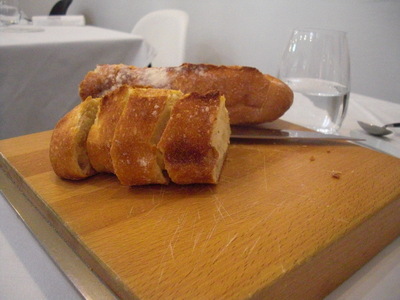 For dinner, we walked to the Table Saint Crescent, a GM four-toque set, incongruously, at a busy traffic rotary across from a bowling alley.
For dinner, we walked to the Table Saint Crescent, a GM four-toque set, incongruously, at a busy traffic rotary across from a bowling alley.
At the left is its cool white interior. At the right a photo of the bread we chose. We were offered a selection of five shapes and flavors, including olive oil, olive chunk, whole wheat and (cultural imperalism rears its ugly head again) cranberry-walnut. All were in large loaves, and we were encouraged, "for the sake of conviviality" to settle on one choice for the table. Our traditional baguette was then taken away, partially sliced, and brought back to the table, with a knife so that we could slice more as needed. Very good bread.
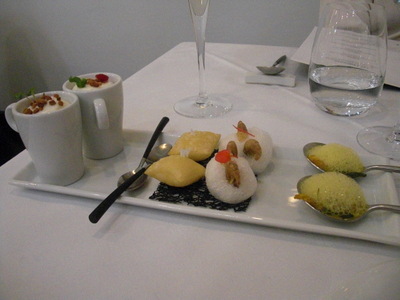
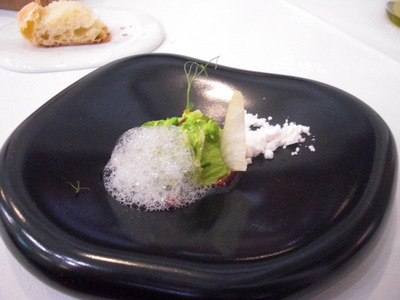 The first amuse-bouche, served with David's introductory glass of champagne (itself served from the champagne-by-the-glass trolley) was four-fold. In the spoons are cooked periwinkles with a dab of some sweet sauce and topped with saffron foam. The white objects are bundles of salted cotton candy decorated with fruit bits and pistachios, a bigonia flower (edible), and a "fossilized shrimp" (a small shrimp cooked in some way until it was crisp all the way through and hollow, shell and all). In the cups was "vegetable cappucino," green pea soup with seafood bits in it, topped with salted whipped cream, chives, and minute crispy croutons. Most intriguing of all were the little brown cushions, which we were cautioned to eat in one bite, lest they splatter. They were perfectly crisp little hollow fritters, each containing a spoonful of warm, perfectly delicious olive oil (we think; the waiter tried to explain, but between his accent and the strange vocabulary having to do with the pressing method, we couldn't be sure; very tasty oil, anyway). As far as we could tell, the chef must have fried up the fritters, used a hypodermic needle to inject the oil, and then plugged the holes with the little garlic-chive flowers you can see stuck into them. All yummy.
The first amuse-bouche, served with David's introductory glass of champagne (itself served from the champagne-by-the-glass trolley) was four-fold. In the spoons are cooked periwinkles with a dab of some sweet sauce and topped with saffron foam. The white objects are bundles of salted cotton candy decorated with fruit bits and pistachios, a bigonia flower (edible), and a "fossilized shrimp" (a small shrimp cooked in some way until it was crisp all the way through and hollow, shell and all). In the cups was "vegetable cappucino," green pea soup with seafood bits in it, topped with salted whipped cream, chives, and minute crispy croutons. Most intriguing of all were the little brown cushions, which we were cautioned to eat in one bite, lest they splatter. They were perfectly crisp little hollow fritters, each containing a spoonful of warm, perfectly delicious olive oil (we think; the waiter tried to explain, but between his accent and the strange vocabulary having to do with the pressing method, we couldn't be sure; very tasty oil, anyway). As far as we could tell, the chef must have fried up the fritters, used a hypodermic needle to inject the oil, and then plugged the holes with the little garlic-chive flowers you can see stuck into them. All yummy.
Second amuse-bouch: The chef's version of a French green pea—a dollop of delicious coarse green-pea purée resting on a bed of bacon bits, pierced by a triangular slice of lettuce rib, decorated with a pea tendril, and accompanied by a pea-flavored foam. We never did figure out what the white powder was—not powdered sugar but very faintly sweet. It showed up again on one of the desserts. Super yummy!

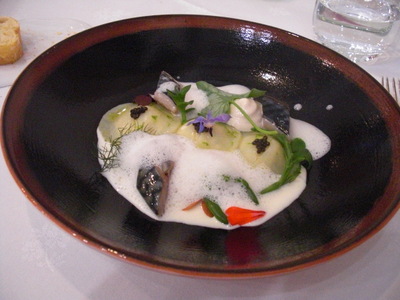 First course, David: Described as a "marbled soft boiled egg," it turned out to be an egg slow cooked at very low temperature, with its shell cracked so that flavorings (truffle, we think) in the water seeped in to leave a marbled pattern on the surface. It rested on a bed of finely minced morels, toasted sunflower seeds, and asparagus. The garnish is chickweed, and the cracker seemed to be a toasted sheet of that finely shredded filo dough used in Greek pastries. The eggwhite was just barely solid—still transparent toward the center—but the yolk was creamy, a result of the long slow cooking.
First course, David: Described as a "marbled soft boiled egg," it turned out to be an egg slow cooked at very low temperature, with its shell cracked so that flavorings (truffle, we think) in the water seeped in to leave a marbled pattern on the surface. It rested on a bed of finely minced morels, toasted sunflower seeds, and asparagus. The garnish is chickweed, and the cracker seemed to be a toasted sheet of that finely shredded filo dough used in Greek pastries. The eggwhite was just barely solid—still transparent toward the center—but the yolk was creamy, a result of the long slow cooking.
First course, me: The chef's take on the classic combination of mackerel with potato salad. The dish arrived under a tall glass cloche full of smoke, which the waiter lifted off to release the smoke (which drifted off toward the ceiling) and to reveal slices of mackerel cooked "au bleu" (that is, gently poached) surrounding three "ravioli" made of cooked potato slices enclosing absolutely delicious finely chopped potato salad and topped with bits of "Alverta Royal" caviare. The whole was garnished with a wide variety of tangy plant sprigs: salicornia, portulaca, dill, sorrel, shiso, flower petals, etc. The waiter than spooned on an emulsion of cockles and yuzu. The mackerel was incredibly moist and tender, and the whole dish was outstanding.

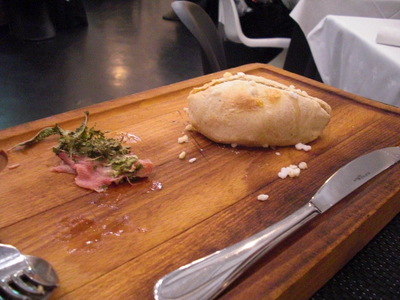 Main course, David: Roasted pigeon. At the left is the plate as it arrived at the table, with its colorful assortment of spring veggies. The central yellow "celery rib" is actually poached rhubarb, and the brown bits are the wing, leg, thigh, and giblets of the pigeon, sautéed, rare, in brown butter (David gave me the parts with bones in them).
Main course, David: Roasted pigeon. At the left is the plate as it arrived at the table, with its colorful assortment of spring veggies. The central yellow "celery rib" is actually poached rhubarb, and the brown bits are the wing, leg, thigh, and giblets of the pigeon, sautéed, rare, in brown butter (David gave me the parts with bones in them).
At the right is the breast of the pigeon, which was brought out on a carving board on a trolley, still enveloped in the "sugar crust" (a sugared flour dough, sprinkled with pear sugar) in which it was roasted. The waiter has slit open the crust and extracted the boneless pigeon breast. Before serving placing it on David's plate, he also removed the thick thatch of "verveine citronelle" (lemon verbena) that covered it inside the dough.
Trolleys featured prominently in the establishment's service. Whenever someone ordered the "foie gras of goose roasted whole," a trolley appeared on which, sure enough, the entire liver (bigger than a football) rested, and the waiter ceremoniously carved off a slice for the diner. By the time we had dessert then were down to the stub end; I don't know whether another was waiting in the kitchen for late diners or whether they had to take it off the menu when it was gone. They also had a cheese trolley, of course, and several of the other dishes required trolley service as well.
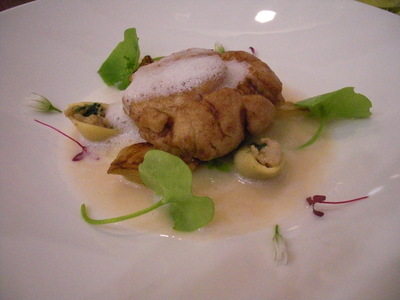
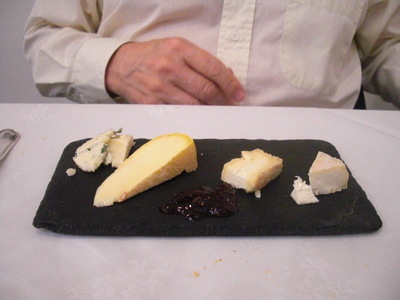 For example, my main course, sweetbreads "roasted and smoked on the grill" arrived (on a trolley) still on its own little square stainless steel grill, raised on stainless steel feet, and the whole (grill and all) encased in a huge square of clear cellophane swepted up and tied into a fluffy topknot like the wrapping on an easter basket and filled, again, with smoke. The waiter produced scissors, snipped off the topknot, releasing the smoke toward the ceiling (they must have to scrub the ceiling weekly), and transferred the sweetbreads to my plate, already arrayed with a bed of onion purée, two roasted onion halves, assorted greenery, and three pasta shells stuffed with finely chopped chanterelle mushrooms and baby spinach, and spooned on the sauce, described as "like a carbonara." The ceremony was nice, but the sweetbreads (and their accompaniments) were great! The pigeon, sweetbreads, and foie gras were popular, so the trolleys trundled back and forth all night.
For example, my main course, sweetbreads "roasted and smoked on the grill" arrived (on a trolley) still on its own little square stainless steel grill, raised on stainless steel feet, and the whole (grill and all) encased in a huge square of clear cellophane swepted up and tied into a fluffy topknot like the wrapping on an easter basket and filled, again, with smoke. The waiter produced scissors, snipped off the topknot, releasing the smoke toward the ceiling (they must have to scrub the ceiling weekly), and transferred the sweetbreads to my plate, already arrayed with a bed of onion purée, two roasted onion halves, assorted greenery, and three pasta shells stuffed with finely chopped chanterelle mushrooms and baby spinach, and spooned on the sauce, described as "like a carbonara." The ceremony was nice, but the sweetbreads (and their accompaniments) were great! The pigeon, sweetbreads, and foie gras were popular, so the trolleys trundled back and forth all night.
When the cheese trolley came out, David chose a little wedge of "pelardon" goat cheese, another chevre, some Roquefort, and Reblochon, plus a spoonful of fig jam.

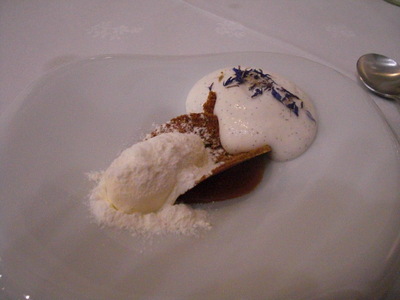 I had a wedge of the same goat cheese, a rather disorganized chunk of quite young Époisse (it was very sticky, and mine ws the first serving from the box, so the waiter had to wrestle with it for some time), and something described as "related to Brie." All were in excellent condition and delicious. The last, in particular, had that barnyard flavor I associate with the cheeses of Normandy, but mildly; just right.
I had a wedge of the same goat cheese, a rather disorganized chunk of quite young Époisse (it was very sticky, and mine ws the first serving from the box, so the waiter had to wrestle with it for some time), and something described as "related to Brie." All were in excellent condition and delicious. The last, in particular, had that barnyard flavor I associate with the cheeses of Normandy, but mildly; just right.
The predessert was variations on milk. On the bottom, a pool of "confiture de lait" (milk jam, a lot like dolce de leche), topped with a fragile cookie. To the left of the cookie a quenelle of ice milk (topped with that same unidentified white powder), and to its right a splodge of strongly vanilla flavored whipped goat cream, sprinkled with dired lavender blossoms. All very tasty.
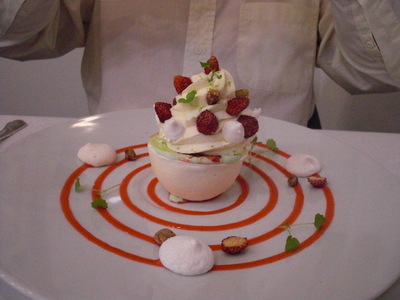
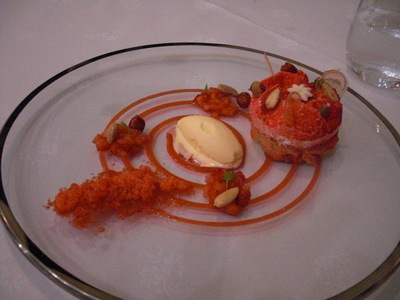 David's dessert, called the "Passionel," was a wild-strawberry vacherin (cream-filled meringue shell) with basil sorbet, combava (citrus) zest, and mascarpone-laced whipped cream. The "bowl" is actually crisp meringue. Just to make sure it was served cold enough, the waiter whipped out a stainless steel bottle a with spray nozzle (just like the one my dermatologist uses) and, while explaining the contents of the dish, spitzed it comprehensively with liquid nitrogen!
David's dessert, called the "Passionel," was a wild-strawberry vacherin (cream-filled meringue shell) with basil sorbet, combava (citrus) zest, and mascarpone-laced whipped cream. The "bowl" is actually crisp meringue. Just to make sure it was served cold enough, the waiter whipped out a stainless steel bottle a with spray nozzle (just like the one my dermatologist uses) and, while explaining the contents of the dish, spitzed it comprehensively with liquid nitrogen!
My dessert, the "Séduction," was merely placed before me. It consisted of orange-flower-water flavored génoise cake topped with a strawberry cream, a flat sheet of strawberries with bitter almond ice cream on top, and at the right, a crumbly portion sour wild-strawberry granité. Around the edges, little heaps of diced wild strawberries with pistachios.
When the waitress rolled over the heavily laden brandy, digestive, liqueur, and cognac trolley, we just laughed, so she whipped open the little wooden chiller box in the center and offered us chocolates instead—white, milk, or dark with different fillings. We each chose one milk chocolate with caramel and almonds and called it a night. The walk home seemed kind of long, and it was getting cool, so we called a taxi.
previous entry
List of Entries
next entry

 The hotel is very proud of hte stylishly asymmetrical backs of its break-fast room chairs, so the staff take care to set each chair at an angle, to give a sort of sails-before-the-wind effect. In the mirror at the far end of the room, you can see me taking the photo.
The hotel is very proud of hte stylishly asymmetrical backs of its break-fast room chairs, so the staff take care to set each chair at an angle, to give a sort of sails-before-the-wind effect. In the mirror at the far end of the room, you can see me taking the photo.
 David slept really late, finally emerging about 11:45 a.m. and feeling crummy. We set out in search of a pastry for him and made it all the way to the Place de l'Hotel de Ville before settling at Romulus Caffé, just a couple of doors from l'Agora. They had croissants left from breakfast, so he had two of those and a hot chocolate served in a double-walled clear plastic cup.
David slept really late, finally emerging about 11:45 a.m. and feeling crummy. We set out in search of a pastry for him and made it all the way to the Place de l'Hotel de Ville before settling at Romulus Caffé, just a couple of doors from l'Agora. They had croissants left from breakfast, so he had two of those and a hot chocolate served in a double-walled clear plastic cup. 
 From the Romulus, it was just a few steps to have a look at the excavated section of the Via Domitia (named after the emperor Domitian) in the center of the square. The café tables and chairs in the background are at present ground level, and the bottom of the pit consists of a small portion of the original roadbed. If you follow its line across the square beyond this photo, it is continued in Rue Droite ("Straight Street"), which at least for its first few blocks follows the arrow-straight route of the original Roman road, which connected Italy with Spain. If you follow it in the other direction, it leads across the oldest (and once the only) bridge over the river/canal. The bridge is unusual in that was (and still is) lined with shops on both sides, all the way over; you can't tell you're on a bridge at all until you emerge and realize you're on the other side of the water. From both ends, it just looks like a narrow shopping street.
From the Romulus, it was just a few steps to have a look at the excavated section of the Via Domitia (named after the emperor Domitian) in the center of the square. The café tables and chairs in the background are at present ground level, and the bottom of the pit consists of a small portion of the original roadbed. If you follow its line across the square beyond this photo, it is continued in Rue Droite ("Straight Street"), which at least for its first few blocks follows the arrow-straight route of the original Roman road, which connected Italy with Spain. If you follow it in the other direction, it leads across the oldest (and once the only) bridge over the river/canal. The bridge is unusual in that was (and still is) lined with shops on both sides, all the way over; you can't tell you're on a bridge at all until you emerge and realize you're on the other side of the water. From both ends, it just looks like a narrow shopping street.
 The roman horreum is considered one of Narbonne's premier attractions, open to the public only since 1975. Although it's subterranean, dank, and arguably creepy enough to invite the inference, the word "horreum" has nothing to do with horror. It's just the underground storage cellar of a very large Roman commercial establish of some sort. It's thought to have been three- or four-sided originally, arranged in a square around an unexcavated center section, but only parts of two sides have been excavated and cleaned out. Now, each small side chamber of the central arcade showed here on the right serves to display some object or artifact found during the excavations. I love the great job my little digital camera does of taking nonflash photos by the rather dim lighting.
The roman horreum is considered one of Narbonne's premier attractions, open to the public only since 1975. Although it's subterranean, dank, and arguably creepy enough to invite the inference, the word "horreum" has nothing to do with horror. It's just the underground storage cellar of a very large Roman commercial establish of some sort. It's thought to have been three- or four-sided originally, arranged in a square around an unexcavated center section, but only parts of two sides have been excavated and cleaned out. Now, each small side chamber of the central arcade showed here on the right serves to display some object or artifact found during the excavations. I love the great job my little digital camera does of taking nonflash photos by the rather dim lighting.
 As you can see from my photos, especially the one on the right here, they are developing an algae problem because of the lights. All the photos under these lighting conditions have a greenish caste, but you can really see the patches of green on the right-hand photo.
As you can see from my photos, especially the one on the right here, they are developing an algae problem because of the lights. All the photos under these lighting conditions have a greenish caste, but you can really see the patches of green on the right-hand photo.
 We still had some time left after the Horreum, so we chose the museum of art and history, the smaller of the two in the Bishop's Palace. On the way up the stairs to its entrance, I was able to get this shot out a window overlooking the Bishop's Terrace and its sedum garden, and to answer for myself the question of whether the colors were supposed to form an image or a word—apparently not, or if so, it's long since been obliterated by random growth.
We still had some time left after the Horreum, so we chose the museum of art and history, the smaller of the two in the Bishop's Palace. On the way up the stairs to its entrance, I was able to get this shot out a window overlooking the Bishop's Terrace and its sedum garden, and to answer for myself the question of whether the colors were supposed to form an image or a word—apparently not, or if so, it's long since been obliterated by random growth.
 Extremely revelatory, at least to us, was a major exhibit on French "orientalism." When Americans say "oriental," they usually mean Asian, but it turns out that, in French, "oriental" means middle-eastern! Boy did that cast new light on a lot of stuff. The "orientalist" movement was a major one in France, and the curators thoughtfully provided a time line of it, beginning in the early 18th century with the appearance of the first French edition of the 1001 Nights and Montesquieu's Persian Letters, running through the French presence in north Africa (inspiring operas, novels, paintings, plays, memoires, etc.), and finally ending in 1962 when the French left Algeria. These two photos show the decor of the two rooms dedicated to examples of the movement. Wow.
Extremely revelatory, at least to us, was a major exhibit on French "orientalism." When Americans say "oriental," they usually mean Asian, but it turns out that, in French, "oriental" means middle-eastern! Boy did that cast new light on a lot of stuff. The "orientalist" movement was a major one in France, and the curators thoughtfully provided a time line of it, beginning in the early 18th century with the appearance of the first French edition of the 1001 Nights and Montesquieu's Persian Letters, running through the French presence in north Africa (inspiring operas, novels, paintings, plays, memoires, etc.), and finally ending in 1962 when the French left Algeria. These two photos show the decor of the two rooms dedicated to examples of the movement. Wow.
 For dinner, we walked to the Table Saint Crescent, a GM four-toque set, incongruously, at a busy traffic rotary across from a bowling alley.
For dinner, we walked to the Table Saint Crescent, a GM four-toque set, incongruously, at a busy traffic rotary across from a bowling alley. 
 The first amuse-bouche, served with David's introductory glass of champagne (itself served from the champagne-by-the-glass trolley) was four-fold. In the spoons are cooked periwinkles with a dab of some sweet sauce and topped with saffron foam. The white objects are bundles of salted cotton candy decorated with fruit bits and pistachios, a bigonia flower (edible), and a "fossilized shrimp" (a small shrimp cooked in some way until it was crisp all the way through and hollow, shell and all). In the cups was "vegetable cappucino," green pea soup with seafood bits in it, topped with salted whipped cream, chives, and minute crispy croutons. Most intriguing of all were the little brown cushions, which we were cautioned to eat in one bite, lest they splatter. They were perfectly crisp little hollow fritters, each containing a spoonful of warm, perfectly delicious olive oil (we think; the waiter tried to explain, but between his accent and the strange vocabulary having to do with the pressing method, we couldn't be sure; very tasty oil, anyway). As far as we could tell, the chef must have fried up the fritters, used a hypodermic needle to inject the oil, and then plugged the holes with the little garlic-chive flowers you can see stuck into them. All yummy.
The first amuse-bouche, served with David's introductory glass of champagne (itself served from the champagne-by-the-glass trolley) was four-fold. In the spoons are cooked periwinkles with a dab of some sweet sauce and topped with saffron foam. The white objects are bundles of salted cotton candy decorated with fruit bits and pistachios, a bigonia flower (edible), and a "fossilized shrimp" (a small shrimp cooked in some way until it was crisp all the way through and hollow, shell and all). In the cups was "vegetable cappucino," green pea soup with seafood bits in it, topped with salted whipped cream, chives, and minute crispy croutons. Most intriguing of all were the little brown cushions, which we were cautioned to eat in one bite, lest they splatter. They were perfectly crisp little hollow fritters, each containing a spoonful of warm, perfectly delicious olive oil (we think; the waiter tried to explain, but between his accent and the strange vocabulary having to do with the pressing method, we couldn't be sure; very tasty oil, anyway). As far as we could tell, the chef must have fried up the fritters, used a hypodermic needle to inject the oil, and then plugged the holes with the little garlic-chive flowers you can see stuck into them. All yummy.
 First course, David: Described as a "marbled soft boiled egg," it turned out to be an egg slow cooked at very low temperature, with its shell cracked so that flavorings (truffle, we think) in the water seeped in to leave a marbled pattern on the surface. It rested on a bed of finely minced morels, toasted sunflower seeds, and asparagus. The garnish is chickweed, and the cracker seemed to be a toasted sheet of that finely shredded filo dough used in Greek pastries. The eggwhite was just barely solid—still transparent toward the center—but the yolk was creamy, a result of the long slow cooking.
First course, David: Described as a "marbled soft boiled egg," it turned out to be an egg slow cooked at very low temperature, with its shell cracked so that flavorings (truffle, we think) in the water seeped in to leave a marbled pattern on the surface. It rested on a bed of finely minced morels, toasted sunflower seeds, and asparagus. The garnish is chickweed, and the cracker seemed to be a toasted sheet of that finely shredded filo dough used in Greek pastries. The eggwhite was just barely solid—still transparent toward the center—but the yolk was creamy, a result of the long slow cooking.
 Main course, David: Roasted pigeon. At the left is the plate as it arrived at the table, with its colorful assortment of spring veggies. The central yellow "celery rib" is actually poached rhubarb, and the brown bits are the wing, leg, thigh, and giblets of the pigeon, sautéed, rare, in brown butter (David gave me the parts with bones in them).
Main course, David: Roasted pigeon. At the left is the plate as it arrived at the table, with its colorful assortment of spring veggies. The central yellow "celery rib" is actually poached rhubarb, and the brown bits are the wing, leg, thigh, and giblets of the pigeon, sautéed, rare, in brown butter (David gave me the parts with bones in them). 
 For example, my main course, sweetbreads "roasted and smoked on the grill" arrived (on a trolley) still on its own little square stainless steel grill, raised on stainless steel feet, and the whole (grill and all) encased in a huge square of clear cellophane swepted up and tied into a fluffy topknot like the wrapping on an easter basket and filled, again, with smoke. The waiter produced scissors, snipped off the topknot, releasing the smoke toward the ceiling (they must have to scrub the ceiling weekly), and transferred the sweetbreads to my plate, already arrayed with a bed of onion purée, two roasted onion halves, assorted greenery, and three pasta shells stuffed with finely chopped chanterelle mushrooms and baby spinach, and spooned on the sauce, described as "like a carbonara." The ceremony was nice, but the sweetbreads (and their accompaniments) were great! The pigeon, sweetbreads, and foie gras were popular, so the trolleys trundled back and forth all night.
For example, my main course, sweetbreads "roasted and smoked on the grill" arrived (on a trolley) still on its own little square stainless steel grill, raised on stainless steel feet, and the whole (grill and all) encased in a huge square of clear cellophane swepted up and tied into a fluffy topknot like the wrapping on an easter basket and filled, again, with smoke. The waiter produced scissors, snipped off the topknot, releasing the smoke toward the ceiling (they must have to scrub the ceiling weekly), and transferred the sweetbreads to my plate, already arrayed with a bed of onion purée, two roasted onion halves, assorted greenery, and three pasta shells stuffed with finely chopped chanterelle mushrooms and baby spinach, and spooned on the sauce, described as "like a carbonara." The ceremony was nice, but the sweetbreads (and their accompaniments) were great! The pigeon, sweetbreads, and foie gras were popular, so the trolleys trundled back and forth all night.
 I had a wedge of the same goat cheese, a rather disorganized chunk of quite young Époisse (it was very sticky, and mine ws the first serving from the box, so the waiter had to wrestle with it for some time), and something described as "related to Brie." All were in excellent condition and delicious. The last, in particular, had that barnyard flavor I associate with the cheeses of Normandy, but mildly; just right.
I had a wedge of the same goat cheese, a rather disorganized chunk of quite young Époisse (it was very sticky, and mine ws the first serving from the box, so the waiter had to wrestle with it for some time), and something described as "related to Brie." All were in excellent condition and delicious. The last, in particular, had that barnyard flavor I associate with the cheeses of Normandy, but mildly; just right.
 David's dessert, called the "Passionel," was a wild-strawberry vacherin (cream-filled meringue shell) with basil sorbet, combava (citrus) zest, and mascarpone-laced whipped cream. The "bowl" is actually crisp meringue. Just to make sure it was served cold enough, the waiter whipped out a stainless steel bottle a with spray nozzle (just like the one my dermatologist uses) and, while explaining the contents of the dish, spitzed it comprehensively with liquid nitrogen!
David's dessert, called the "Passionel," was a wild-strawberry vacherin (cream-filled meringue shell) with basil sorbet, combava (citrus) zest, and mascarpone-laced whipped cream. The "bowl" is actually crisp meringue. Just to make sure it was served cold enough, the waiter whipped out a stainless steel bottle a with spray nozzle (just like the one my dermatologist uses) and, while explaining the contents of the dish, spitzed it comprehensively with liquid nitrogen!